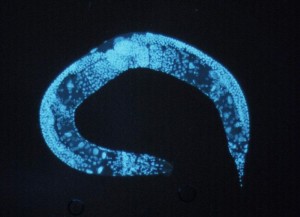SUNDAY, 8 JANUARY 2012
Parkinson’s disease affects approximately 120,000 people in the UK and half a million in the USA. The disease develops due to loss of dopamine-producing cells in the brain, causing the characteristic symptoms of shaking, rigidity and slow movement. The ‘parkinsonian’ C. elegans worms have been mutated to lack dopaminergic cells, and have difficulty in switching from swimming to crawling when removed from water. Researchers found that although the worms could crawl well, and swim well when in a puddle, the worms would become rigid for up to half an hour when the puddle was removed. This mimics the difficulty with motor transitions experienced by people with Parkinson’s disease.To identify potential drugs, the dopamine-deficient worms are given a drug and then put through the process leading to immobility. If the worms are immobilised when the water is removed, another drug is tested. However, if the drug enables the worm to make the transition from swimming to crawling, it could potentially be beneficial to those with Parkinson’s disease.
Team leader, Pierce-Shimomura, says that despite humans having a more complex nervous system than worms, the two species have a common conserved genetic structure with regards to their dopaminergic systems. A treatment that works in worms may thus also work in humans, and can be tested in worms very quickly. So far, tests have yielded one potential therapeutic compound, which is already approved for use in humans for treatment of another disorder.
Usually, such drugs are tested on mice, but this process can be expensive and time-consuming. The use of ‘parkinsonian’ worms could overcome such barriers, maximising the chances of finding suitable therapies for this debilitating disease.
Written by Mrinalini Dey

